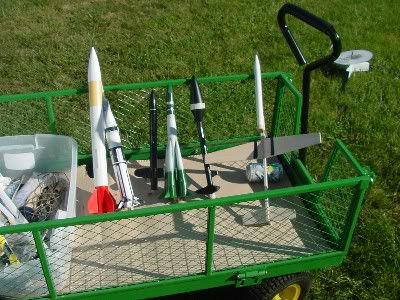JStarStar
Well-Known Member
- Joined
- Jun 5, 2009
- Messages
- 2,552
- Reaction score
- 78
I have an Electron Beam controller I use for most of my schoolyard-level rockets, which of course run on four AA batteries and seem to be OK for normal duty.
The consensus seems to be that the Electron Beam will not reliably launch clusters, that you need more current to fire multiple igniters. I've got a couple cluster rockets I'm about ready to start launching, so I need to make sure my ignition system can do the job.
I also have an older Estes Launch Control System I kept from years and years ago - I soldered all the connections and it still works fine - and a newer control system I got with my Hobby Labs SR-71 kit, both of which use external power systems. I modified the Estes LCS to use an auto cigarette-lighter plug, so that's fine if I have a car handy, but not all launch areas allow you to drive the car right up to within 20 feet of the launch pad.
So I'm gonna need another portable power source (i.e. battery), in case I want to launch somewhere a little off the pavement where I can't drive my car.
I was looking for something rechargeable with plenty of power yet still lightweight enough that you can carry it a hundred yards or so without developing a hernia. (So that lets out a normal auto battery).
Would something like this work? This seems to be a good thing to have in the garage for other reasons, could I just hook up the battery leads of the LCS to this thing and let it rip? Has anybody else used these things as power sources? Any reasons it WOULDN'T work??
portable jump-starter

The consensus seems to be that the Electron Beam will not reliably launch clusters, that you need more current to fire multiple igniters. I've got a couple cluster rockets I'm about ready to start launching, so I need to make sure my ignition system can do the job.
I also have an older Estes Launch Control System I kept from years and years ago - I soldered all the connections and it still works fine - and a newer control system I got with my Hobby Labs SR-71 kit, both of which use external power systems. I modified the Estes LCS to use an auto cigarette-lighter plug, so that's fine if I have a car handy, but not all launch areas allow you to drive the car right up to within 20 feet of the launch pad.
So I'm gonna need another portable power source (i.e. battery), in case I want to launch somewhere a little off the pavement where I can't drive my car.
I was looking for something rechargeable with plenty of power yet still lightweight enough that you can carry it a hundred yards or so without developing a hernia. (So that lets out a normal auto battery).
Would something like this work? This seems to be a good thing to have in the garage for other reasons, could I just hook up the battery leads of the LCS to this thing and let it rip? Has anybody else used these things as power sources? Any reasons it WOULDN'T work??
portable jump-starter







